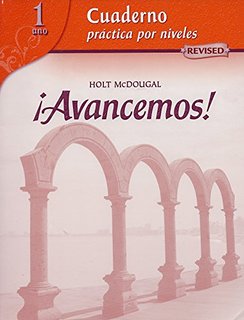
All Solutions
Page 40: Leer C
Reading with comprehension.
Read twice through the text to understand it fully. It contains many descriptions. Then, continue with the questions. You will find that questions 1, 3 and 4 are rather straightforward. Refer to the text and respond using information found therein.
Regarding question number 2, you will see that is asks you why Alberto is a good student. By now, you have learned that the interrogative phrase “por qué” is used to ask “why”, whereas the causative conjunction “porque” is used to say “because”. This subtle difference in morphology is what changes the meaning of the two expressions. Be careful when using one or the other.
Below, you will find examples of how your answers should look like. Keep in mind that, the more complex language becomes, it offers you more freedom of expression. This is to advise you that the below examples are not the only correct ways of answering these questions.
1. La maestra es una mujer joven de Paraguay.
2. Sí, Alberto es un estudiante bueno. Es bueno porque le gusta estudiar.
3. Andrés es alto y tiene el pelo castaño. No le gusta hacer la tarea, pero es artístico porque le gusta dibujar. También es un chico simpático.
4. Felipe es grande y rubio. Es muy simpático, pero también un poco desorganizado.
Reading with comprehension, and writing in Spanish.
There are two questions in this exercise. The first one refers to the text. If necessary, read the text once again and respond.
The second question is a personal one. Its purpose is for you to describe some of your classmates just like the author does in the text. Given the personal nature of the question, only refer to its respective example as a reference of how your answer might look like. Both questions will be analysed below in separate paragraphs.
Nowhere in the text does it say that they are good friends. However, based on the fact that they are described in a relevantly detailed manner, we may deduce that they are good friend. Thus, you may respond along these lines:
Sí, los chicos son buenos amigos. Alberto describe a sus amigos en mucho detalle y los conoce bien.
Once again, this is a personal question, thus only use this example as a reference.
Cindy es una chica muy simpática. Tiene el pelo castaño y es un poco baja. Le gusta dibujar y escuchar música. Matt es muy trabajador y atlético, pero poco estudioso. No le gusta hacer la tarea porque practica muchos deportes. Johnny es alto y pelirrojo. A él le gusta estudiar y jugar a videojuegos. Es un chico simpático.
You have to answer two questions. For the first one, you might have to reread the text on the same page and then answer. For the second one, you should use vocabulary to describe your classmates.
You can choose if you want your answer to be one sentence, or you can divide it into two.
– Sí, los chicos son buenos amigos. Alberto describe cómo son los amigos y conoce bien los hobbies de ellos.
*(Yes, the boys are good friends. Alberto describes what the friends are like and knows well their hobbies.)*
– Los chicos son buenos amigos porque Alberto describe cómo son los amigos y conoce bien los hobbies de ellos.
*(They are good friends because Alberto describes what the friends are like and knows well their hobbies.)*
Use the beginnings of the sentences below to describe your classmates. To complete the sentences, use the adjectives you have learned so far that apply to your classmates.
– *(Girl name)* tiene el pelo castaño y es baja. Ella es muy intelligente y simpática.
*((Girl name) has brown hair and is short. She is very intelligent and nice.)*
– *(Boy name)* tiene el pelo rubio y es muy alto. Él es muy atlético y juega al básquetbol.
*((Boy name) has blond hair and is very tall. He is very athletic and plays basketball.)*

